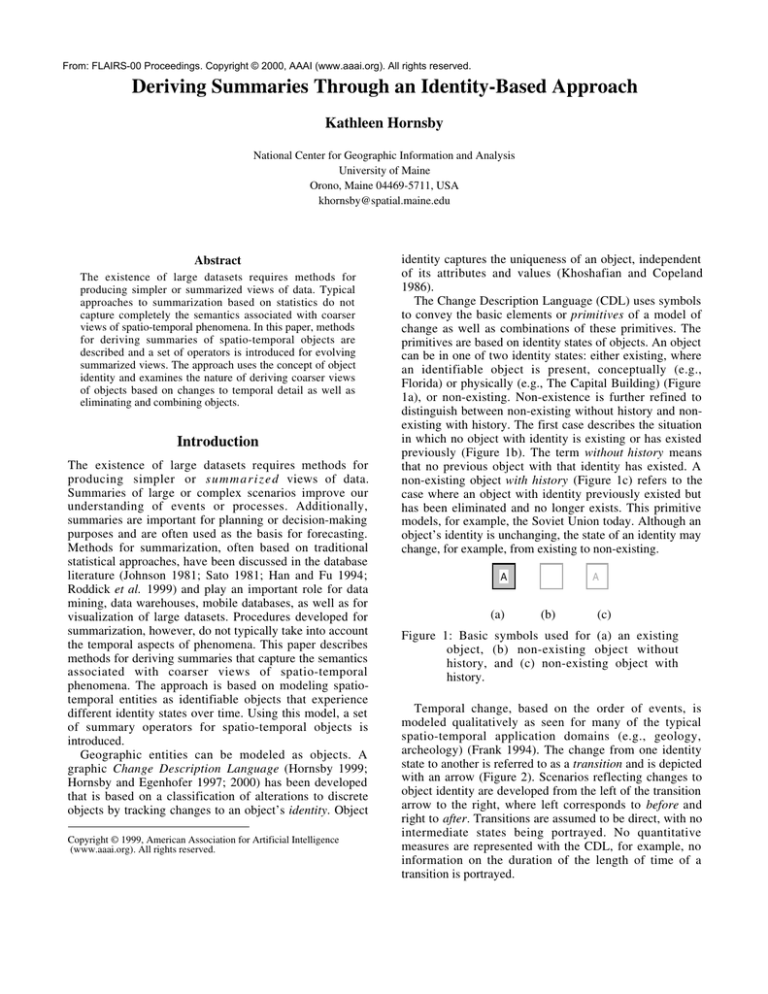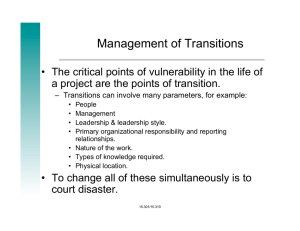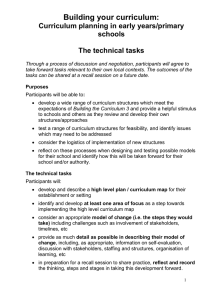
From: FLAIRS-00 Proceedings. Copyright © 2000, AAAI (www.aaai.org). All rights reserved.
Deriving Summaries Through an Identity-Based Approach
Kathleen Hornsby
National Center for Geographic Information and Analysis
University of Maine
Orono, Maine 04469-5711, USA
khornsby@spatial.maine.edu
Abstract
The existence of large datasets requires methods for
producing simpler or summarized views of data. Typical
approaches to summarization based on statistics do not
capture completely the semantics associated with coarser
views of spatio-temporal phenomena. In this paper, methods
for deriving summaries of spatio-temporal objects are
described and a set of operators is introduced for evolving
summarized views. The approach uses the concept of object
identity and examines the nature of deriving coarser views
of objects based on changes to temporal detail as well as
eliminating and combining objects.
Introduction
The existence of large datasets requires methods for
producing simpler or s u m m a r i z e d views of data.
Summaries of large or complex scenarios improve our
understanding of events or processes. Additionally,
summaries are important for planning or decision-making
purposes and are often used as the basis for forecasting.
Methods for summarization, often based on traditional
statistical approaches, have been discussed in the database
literature (Johnson 1981; Sato 1981; Han and Fu 1994;
Roddick et al. 1999) and play an important role for data
mining, data warehouses, mobile databases, as well as for
visualization of large datasets. Procedures developed for
summarization, however, do not typically take into account
the temporal aspects of phenomena. This paper describes
methods for deriving summaries that capture the semantics
associated with coarser views of spatio-temporal
phenomena. The approach is based on modeling spatiotemporal entities as identifiable objects that experience
different identity states over time. Using this model, a set
of summary operators for spatio-temporal objects is
introduced.
Geographic entities can be modeled as objects. A
graphic Change Description Language (Hornsby 1999;
Hornsby and Egenhofer 1997; 2000) has been developed
that is based on a classification of alterations to discrete
objects by tracking changes to an object’s identity. Object
Copyright © 1999, American Association for Artificial Intelligence
(www.aaai.org). All rights reserved.
identity captures the uniqueness of an object, independent
of its attributes and values (Khoshafian and Copeland
1986).
The Change Description Language (CDL) uses symbols
to convey the basic elements or primitives of a model of
change as well as combinations of these primitives. The
primitives are based on identity states of objects. An object
can be in one of two identity states: either existing, where
an identifiable object is present, conceptually (e.g.,
Florida) or physically (e.g., The Capital Building) (Figure
1a), or non-existing. Non-existence is further refined to
distinguish between non-existing without history and nonexisting with history. The first case describes the situation
in which no object with identity is existing or has existed
previously (Figure 1b). The term without history means
that no previous object with that identity has existed. A
non-existing object with history (Figure 1c) refers to the
case where an object with identity previously existed but
has been eliminated and no longer exists. This primitive
models, for example, the Soviet Union today. Although an
object’s identity is unchanging, the state of an identity may
change, for example, from existing to non-existing.
A
(a)
A
(b)
(c)
Figure 1: Basic symbols used for (a) an existing
object, (b) non-existing object without
history, and (c) non-existing object with
history.
Temporal change, based on the order of events, is
modeled qualitatively as seen for many of the typical
spatio-temporal application domains (e.g., geology,
archeology) (Frank 1994). The change from one identity
state to another is referred to as a transition and is depicted
with an arrow (Figure 2). Scenarios reflecting changes to
object identity are developed from the left of the transition
arrow to the right, where left corresponds to before and
right to after. Transitions are assumed to be direct, with no
intermediate states being portrayed. No quantitative
measures are represented with the CDL, for example, no
information on the duration of the length of time of a
transition is portrayed.
A
A
Figure 2: A transition between two identity states of
an object.
Figure 4: A scenario involving identity states for the
object A.
Systematic combinations of the primitives result in a set
of basic identity-based change operations. Beginning with
a transition between an object that is non-existing without
history and an existing object, the semantics of a create
operation (Figure 3a) are captured. The operation
continue existence reflects a transition between two
states of an existing object (Figure 3b). The removal of an
existing object results in a non-existing object with history
(e l i m i n a t e ) (Figure 3c) or without history
(destroy) (Figure 3d). The transition from a nonexisting object with history to an existing object captures
the semantics of a reincarnate (Figure 3e), describing
the fact that the same identity has existed previously.
The remaining four are combinations of non-existing
identity states: continue non-existence with
history (Figure 3f), a forget operation (Figure 3g),
the transition from a non-existing object without history to
a non-existing object with history describes a recall
operation (Figure 3h), and the operation continue
non-existence without history of an object
(Figure 3i).
Most modeling situations, however, involve more than
one object. The identity-based CDL has been extended to
capture transitions that link multiple objects (Hornsby
1999; Hornsby and Egenhofer 2000). Temporal cooccurrence of transitions affecting different objects is
conveyed through aligning identity states vertically such
that the states of more than one object can be modeled
(Figure 5). In this way, scenarios can be extended to
include multiple objects, such as the example shown in
Figure 5, involving objects—nations, in this
case—associated with the formation of the country
Canada.
A
A
(a)
A
(b)
A
A
(d)
A
A
A
AA
B ritish
Brit. N.
America
Brit.
NorthN.
America
America
British
Colonies
British
Colonies
British
Colonies
British
Colonies
New
France
New
France
New
Fran ce
New
France
New
France
Britain
Britain
Britain
Britain
Britain
France
France
Fran ce
France
France
AA
(f)
AA
(h)
A
(c)
(e)
A
(g)
A
C anad a
A
A
(i)
Figure 3: Operations on single objects: (a) create,
(b) continue existence, (c) eliminate,
(d) d e s t r o y , (e) reincarnate, (f)
continue non-existence with
history, (g) forget, (h) recall, and (i)
continue non-existence without
history.
Identity states can be sequenced together to form a
scenario of change (Figure 4). A scenario reflects a
conceptualization of objects over time and is composed of
a set of identity states linked by transitions.
Figure 5: Co-occurring transitions affecting objects
with different identities are aligned vertically.
This ordering of objects and transitions
models the formation of Canada.
Capturing further complexities in spatio-temporal
scenarios involves modeling additional linkages that also
exist among objects, such as Canada was formed from
British North America (Figure 6a). In more detail, three
transitions can co-occur: one between the two states of
object A (e.g., British North America), another one
between the two states of another object B (e.g., Canada),
and a third between the first state of object A and the
second state of object B—a cross-object transition (Figure
6b). The cross-object transition is symbolized in the CDL
with a diagonal arrow (drawn either upward or downward)
that links two objects of different identity and comprises
many changes involving spatio-temporal objects.
Canad a
Brit. N.
America
Br
itish
Brit.
N
orthN.
America
A
merica
object transitions linking identity states of different objects
are removed, the transitions connecting same-identity
states are left intact (Figure 7b).
British
Colonies
British
Colonies
British
Colonies
British
Colonies
New
Fran ce
New
France
New
France
New
France
New
France
Brit. N.
America
Britain
Britain
Britain
Britain
Britain
(a)
F rance
France
France
France
France
(a)
Canada
Brit. N.
America
Br itish
Brit.
N orthN.
America
A merica
(b)
Figure 6: Spatio-temporal modeling involves (a) crossobject transitions among objects such as (b)
from object British North America
to object Canada.
Canad a
Canada
Br itish
Brit.
N
orthN.
America
A
merica
British
Brit. N.
America
Brit.
NorthN.
America
Amer ica
(b)
Figure 7: DropCT: Reducing detail relating to the
transitions among objects as (a) known crossobject transitions are (b) abstracted away.
Collapsing Transitions among Identity States
Identity states of the same object can be combined through
a Collapse operator (Figure 8a) returning a new view
comprising fewer identity states (Hornsby and Egenhofer
1999) (Figure 8b). This results in a coarsening of temporal
detail over transitions between objects.
A
A
A
(a)
Summarization of Spatio-Temporal Objects
A set of temporal zoom operators has been proposed for
aiding spatio-temporal knowledge representation over
different levels of detail (Hornsby and Egenhofer 1999).
Summarization involves a particular type of shift in detail,
namely, a coarsening in the level of detail. Summaries of
spatio-temporal objects provide less detailed views with
respect to space and time. Coarsening detail returns a new,
less-detailed view of a scenario. Views here are not defined
as visual representations, but rather are abstractions (i.e.,
less detailed views) of identifiable objects and the
transitions between identity states. All scenarios have
multiple views, each of them distinct from the others. Each
view corresponds to a different way of perceiving the
transitions among identity states. Summaries of spatiotemporal objects can be obtained through:
• reducing the detail about transitions among objects,
• collapsing transitions among identity states into fewer
transitions, and
• abstracting objects from a scenario through either
completely removing or combining identities.
(b)
Figure 8: Collapse operation: (a) Two states of
object A that are linked through a transition
are collapsed into (b) a single identity state.
The C o l l a p s e operation uses certain rules for
reasoning about combinations of identity states. Depending
upon the task, a priority can be assigned to identity states
determining the resulting identity state of an object after a
Collapse (Figure 9). The priorities can be: existence
(•E ), followed by non-existing with history; non-existence
(•N); the before-transition state (• 1); or the after-transition
state (State2 in Figure 9 (•2)).
Obje ct
S ta te1
S ta te2
R e su lt of Collapse
(Existe nce ta kes p rio rity)
X
Y
X • EY
A
X •NY
R esu lt of Coll apse
(Stat e2 ta ke s prio rity)
X•2Y
A
A
A
A
A
A
A
A
A
A
A
A
A
A
A
A
A
A
A
A
A
A
A
A
A
A
A
A
A
Reducing Detail about Transitions among Objects
Simpler, summarized views of scenarios are produced by
omitting the details relating to cross-linkages among
entities, for example, abstracting the fact that Canada was
formed from British North America to simply, Canada was
created after British North America was in existence. This
is effected by removing cross-object transitions from a
view–a DropCT operation (Figure 7a). Although cross-
Res u lt of Coll aps e
(Non -exis te nc e
take s priority)
Figure 9: Collapse uses rules for reasoning about
combinations of identity states.
Depending on the priority scheme selected for the
Collapse operation, different results will be obtained
(Figure 10).
Figure 10: Result of Collapse depends on which
priority scheme is selected.
The Collapse operator can be applied iteratively to
obtain views at increasingly coarser levels of temporal
detail. This operator must also return sequences of
transitions that are valid according to a given domain
ontology and therefore it tests for any invalid sequences of
identities as known from combinatorial rules based on a
domain ontology. From this set, for example, sequences of
identities where an intermediate state that is non-existing
without history may not be plausible.
For deriving summaries based on scenarios involving
multiple objects, the Collapse operation is performed
over sets of objects (Figure 11a). Collapse can be
applied iteratively until the coarsest level of detail is
reached, i.e., where only identity states at one time are
modeled (Figure 11b). In this case, the summary may
contain information regarding objects that are non-existing,
such as former colonies, as well as existing objects.
Canada
Brit. N.
America
British
Brit. N.
North
America
Amer
ica
C anada
C anada
Brit. N.
America
Brit. N.
America
British
Colonies
British
Colonies
British
Colonies
British
Colonies
British
Colonies
British
Colonies
British
Colonies
British
Colonies
New
France
New
France
New
France
New
France
New
France
New
France
New
France
New
France
Britain
Britain
Britain
Britain
Bri tain
Britain
Brit ain
B rit ain
France
France
France
France
France
France
France
France
(a)
(b)
Figure 11: Summaries can be obtained through (a) a
Collapse operation being applied to sets of
objects, possibly abstracting (b) all transitions
and identity states until only identities at one
time remain.
Abstracting Objects from Scenarios
Summarization can also require that entire objects are
abstracted from a scenario based on semantics that involve
either eliminating or combining less relevant objects to
remove them from a scenario.
Removing Objects
Summarized views are obtained through a DropObject
operation where all identity states associated with one or
more objects are abstracted (Figure 12a). The removal of
objects is based on domain knowledge and relies on
criteria such as the number of transitions involving nonexisting identity states or the number of cross-object
transitions. An object that goes out of existence earlier in a
scenario, for instance, may be less likely to be relevant to a
summary than other objects. Similarly, objects that are not
linked by any cross-object transitions may be abstracted
more readily than objects that are linked to others through
cross-object transitions. DropObject must include
support for reasoning about cross-object transitions after
abstraction. Certain adjustments to these transitions may be
necessary, as the results of eliminating objects may not be
plausible given certain contexts (Figure 12b). Alterations
to the transitions, such as initiating the transition from the
most recent existing identity state, may be
undertaken(Figure 12c).
(a)
(b)
(c)
Figure 12: DropObject (a) abstracts objects from a
scenario resulting in (b) fewer identities and
transitions and (c) adjusts the cross-object
transition to begin with the most recent
existing object.
Combining Objects
Summaries can be derived by combining or merging two
or more objects (Hornsby and Egenhofer 1997) resulting in
a view involving fewer objects (Figure 13). This can
happen in at least two ways. In the first case, when objects
are abstracted from a scenario, a smaller number of new
identities take their place. Britain and France, for
example, can be combined into new object, Europe. The
new identity inherits any cross-object transitions that are
linked to the identity states of predecessor objects. Similar
to the Collapse operation, Merge requires a set of
priority rules for combining the identity states of different
objects.
objects are abstracted from a scenario in addition to
collapsing the transitions among objects. Further work is
necessary, for example, on the effects of combining the
operators and on support for reverting from the
summarized view to the more detailed, original scenario
where information about objects abstracted from the
scenario will need to be retained.
(a)
(b)
Figure 13: Merge operation: (a) combines identities
into (b) a new object. Original identities are
eliminated.
The second type of combine operation, Subsume, refers
to those cases where an object subsumes another object’s
identity. British North America (BNA), for
example, could be combined with Canada such that
Canada continues to exist but BNA is eliminated from the
scenario (Figure 14). At the level of identities, the
subsumed object’s identity disappears–as with a
Merge–leaving the other object’s identity to continue as
an existing object. If object properties were also being
modeled, however, the successor object would inherit the
properties of the subsumed object.
(a)
(b)
Figure 14: Subsume operation where two objects are
combined such that (a) one object is
subsumed into the other (existing) object and
(b) like the M e r g e , a successor object
continues to exist.
Conclusions
Summarized views of objects are important for providing
more meaningful interpretations of data especially in the
context of large databases. This paper has examined
procedures for evolving summaries from an identity-based
perspective. Summaries are coarser views of phenomena
and, depending on the task at hand, can be derived from:
reducing the detail about transitions among objects,
collapsing transitions among identity states into fewer
transitions, and abstracting objects from a scenario through
either completely removing or combining identities.
Summaries can contain details on non-existing objects as
well as existing objects. A set of operators that supports the
derivation of summarized views includes Collapse,
DropCT, DropObject, Merge, and Subsume. Each of
these operators can also be applied in combination with
each other such that cross-object transitions and entire
Acknowledgments
This work was supported in part by grants from the
National Science Foundation SBR-9700465, the National
Imagery and Mapping Agency NMA202-97-1-1023, and
the National Institute of Environmental Health Sciences,
1 R 01 ES09816-01.
References
A. Frank (1994) Qualitative temporal reasoning in GISordered time scales. in: T. Waugh and R. Healey (Ed.),
Proceedings of the Sixth International Symposium on
Spatial Data Handling, Edinburgh, Scotland, pp. 410431.
J. Han and Y. Fu (1994) Dynamic generation and
refinement of concept hierarchies for knowledge
discovery in databases. in: AAAI'94 Workshop on
Knowledge Discovery in Databases, Seattle, WA,
pp. 157-168.
K. Hornsby (1999) Identity-based reasoning about spatiotemporal change. unpublished Ph.D. Thesis,
University of Maine, Orono, ME, USA.
K. Hornsby and M. Egenhofer (1997) Qualitative
Representation of Change. in: S. Hirtle and A. Frank
(Ed.), Spatial Information Theory—A Theoretical
Basis for GIS, International Conference COSIT '97,
Laurel Highlands, PA. Lecture Notes in Computer
Science 1329, Springer-Verlag, Berlin, pp. 15-33.
K. Hornsby and M. Egenhofer (1999) Shifts in detail
through temporal zooming. in: A. Tjoa, A. Cammelli,
and R. Wagner (Ed.), Proceedings of the Tenth
International Workshop on Database and Expert
Systems Applications, DEXA'99, Florence, Italy, pp.
487-491.
K. Hornsby and M. Egenhofer (2000) Identity-based
change: a foundation for spatio-temporal knowledge
representation. International Journal of Geographical
Information Science, Forthcoming.
R. Johnson (1981) Modelling summary data. SIGMOD
Record : 93-97.
S. Khoshafian and G. Copeland (1986) Object identity.
SIGPLAN Notices 21: 406-416.
J. Roddick, M. Mohania, and S. Madria (1999) Methods
and interpretation of database summarisation. in: T.
Bench-Capon, G. Soda, and A. Tjoa (Ed.), Database
and Expert Systems Applications, DEXA'99, Florence,
Italy, pp. 604-615.
H. Sato (1981) Handling summary information in a
database: derivability. SIGMOD Record : 98-107.





